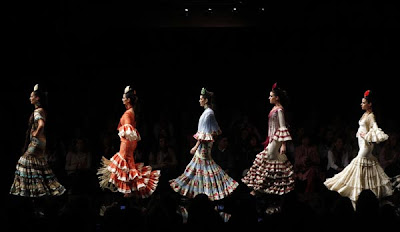Four or five years ago when I first visited Andalucia I was totally in love with flamenco - the music, the guitar... the dance. Everything is filled with passion and balanced with soft sounds of guitar.
Originally Andalucia was a land of muslims, it was ages ago.. After that it had been a place to fight for. Rome and Byzantine along with Moorish cultures had an influence on the locals. Finally there was flamenco.
The origin of the word itself is almost unknown.. due to the varity of spoken Andalucian languages.
George Borrow asserted the word flemenc [sic] is synonymous with "gypsy". Blas Infante, in his book Orígenes de lo flamenco y secreto del cante jondo, suggests the word may derive from Andalusian Arabic fellah mengu, "Escapee Peasant". Infante connects the numerous Muslim Andalusians (Moriscos) who decided to stay and mix with the Romani newcomers when their lands were expropriated because of their religious beliefs.
Other hypotheses include "Fleming, native of Flanders" (Du. Vlaming) and also "flamingo." Spain ruled Flanders for many years, and King Carlos I brought with him to Madrid an entire Flemish court. The "flamingo" derivation suggests a link between the colourful bird and the colourful costumes of the gypsies.
Anyway, the gypsies had an influence on it... we can see it in familiar colourful dresses, hair style, even polkadot is also used by them.
We all know at least one famous Andalucian gypsy.. Her name was Carmen.
The origin of the word itself is almost unknown.. due to the varity of spoken Andalucian languages.
George Borrow asserted the word flemenc [sic] is synonymous with "gypsy". Blas Infante, in his book Orígenes de lo flamenco y secreto del cante jondo, suggests the word may derive from Andalusian Arabic fellah mengu, "Escapee Peasant". Infante connects the numerous Muslim Andalusians (Moriscos) who decided to stay and mix with the Romani newcomers when their lands were expropriated because of their religious beliefs.
Other hypotheses include "Fleming, native of Flanders" (Du. Vlaming) and also "flamingo." Spain ruled Flanders for many years, and King Carlos I brought with him to Madrid an entire Flemish court. The "flamingo" derivation suggests a link between the colourful bird and the colourful costumes of the gypsies.
Anyway, the gypsies had an influence on it... we can see it in familiar colourful dresses, hair style, even polkadot is also used by them.
We all know at least one famous Andalucian gypsy.. Her name was Carmen.
Traditional details of Flamenco costumes are long dresses with tails, ruffles, polkadot, lace, a mens' hat or a hand fan.
International Flamenco Fashion Show takes place in Seville once a year.
Here are some highlights of the last one (February 2011)
Buenas noches, amigos!
V.L.






















No comments:
Post a Comment